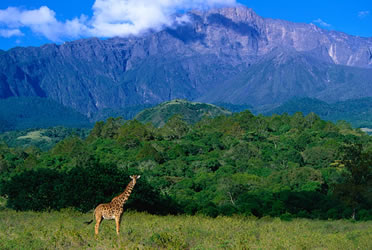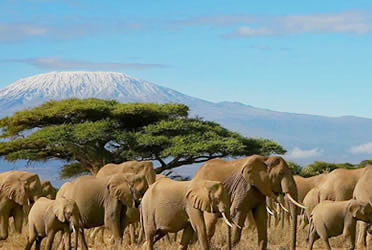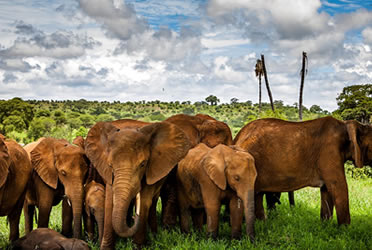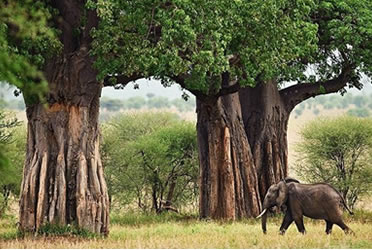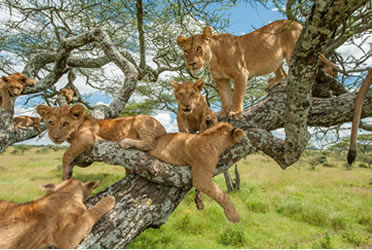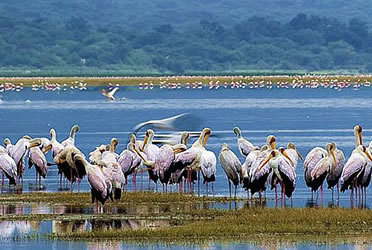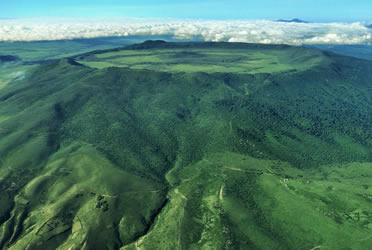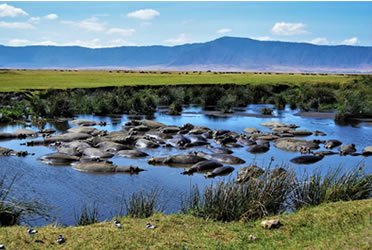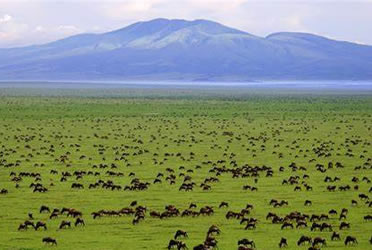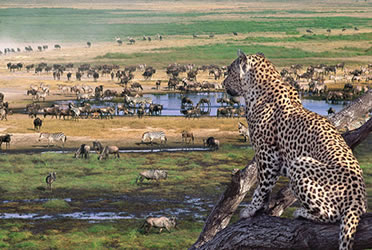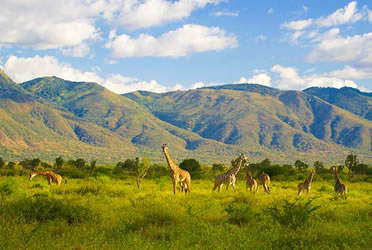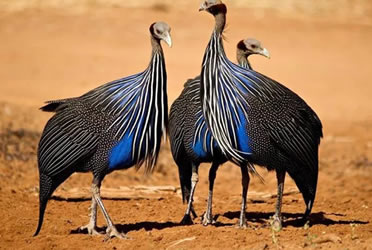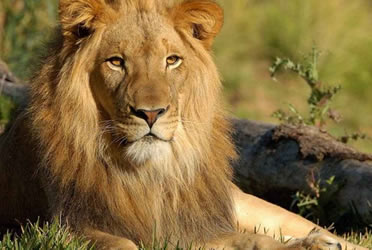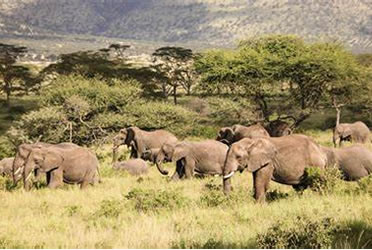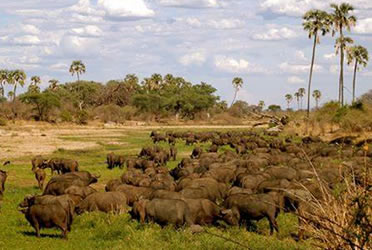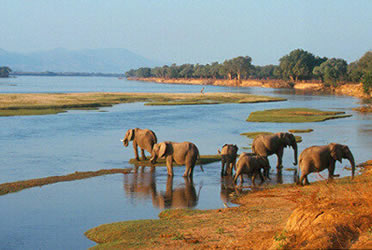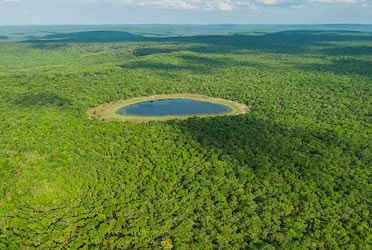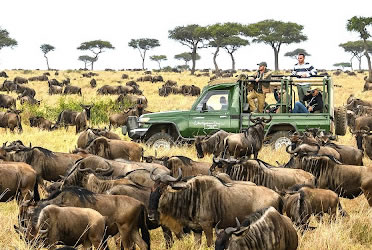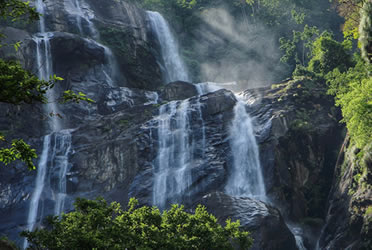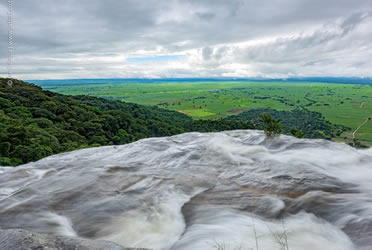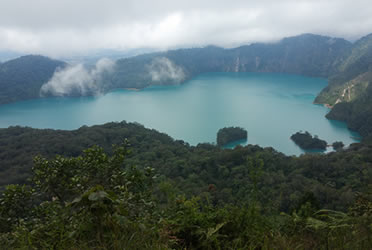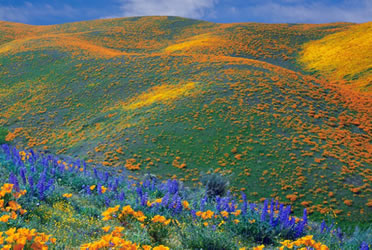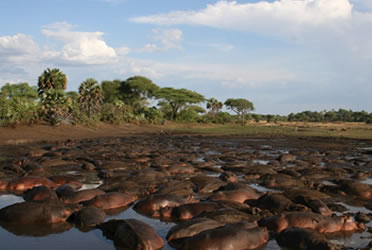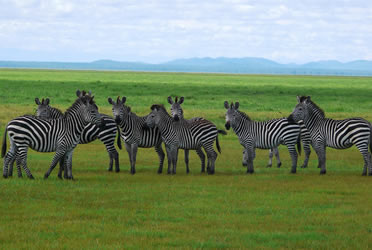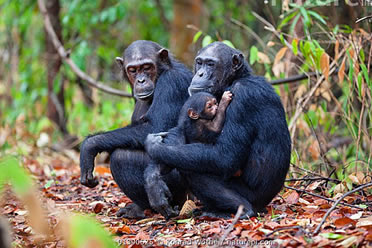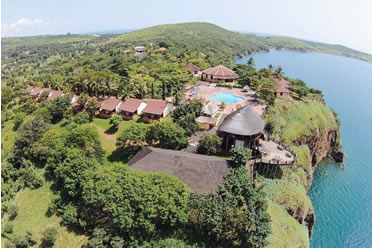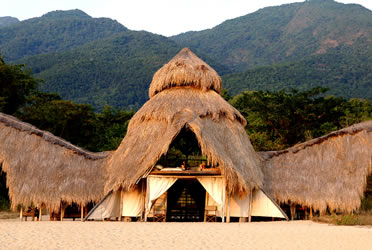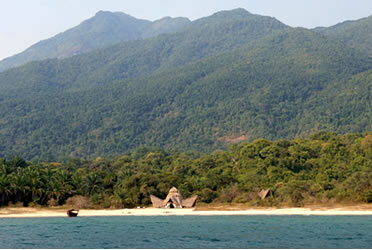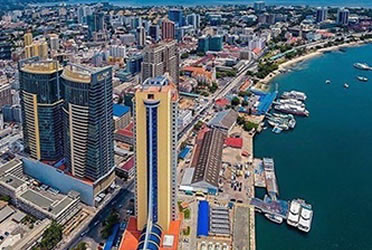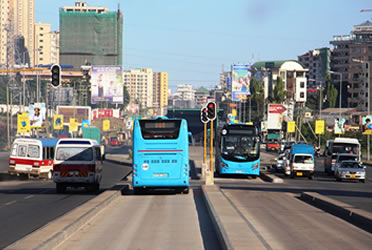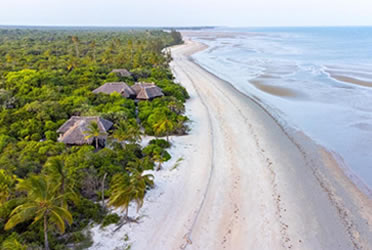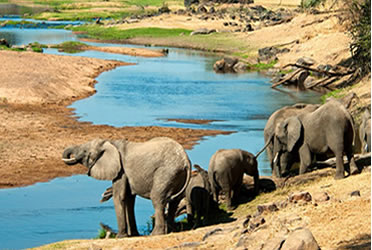Arusha National Park
Arusha National Park is one of the mysterious national parks located in the Northern Tanzania. Northeast of Arusha city. It is famous for being a home to the Tanzania's second highest mountain, Mount Meru and the world's largest population of giraffes. It covers 552 square kilometers. It is 25 kilometers east of Arusha, 58 kilometers from Moshi and 35 kilometers from Kilimanjaro International Airpot (KIA).. It harbors incredible wildlife species that cannot be viewed in other national parks in the northern circuit including vegetation types like the lush rainforest, savannah, alpine vegetation, animals like buffaloes, bushbucks, warthogs, zebras. red duikers, elephants, giraffes, leopards, hippos, primates like black and white colobus monkeys, vervet monkeys, blue monkeys, bird species like grey crowned crane, flamingos, African fish eagle, hartlaub's turaco, secretary birds among others. It takes about 40 minutes' drive to reach Arusha National Park from KIA. This park is highly preferred because it offers both single day visits and multi day visits to visitors from Arusha city. Arusha national park is composed a very scenic landscape with three distinct areas that are the Meru crater funneling the Jekukumia river in the west, Ngurdoto crater in the south-East and the shallow alkaline Momella lakes with varying algae colors in the north east. For the park having small area make it possible for clients to participate in all activities in the park and return bark to Arusha town for overnight.
Makj Unique Tours and Safari are also part of the experience which tourists get as they visit Arusha national park. Arusha national park's name is derived from the local Waarusha people who used to live in the area, great ecological system with many attractions which are highlights of the parks and the reasons why the park is a great tourist destination in the Tanzania. The park is dotted with three varied spectacular landscapes that is Meru crater funnels, Kekukumia River, peak of mount Meru on its rim in the west, Ngurdoto crater in the south-east, the shallow alkaline Momelia lakes in the north-east region of the park. Arusha national park is established with very rich Flora and fauna, tourists can engage in various activities at the park ..
- Quality Hotels & Affordable Accommodations (Available)
- Good Transport Services (Available)
- Safety and Standard Camping (Available)
Tarangire National Park
Tarangire national park is one of the most visited protected areas located in northern part of Tanzania and south of Lake Manyara National Park. The national park was established in 1970 and covers a total area of 2,850 square kilometers which is comprised of grassy plains, savannah and mixed woodland vegetation, baobab and acacia trees which make it the best destination for wildlife viewing. Tarangire national park is famously known for harboring large herds of elephants, other animals like greater and lesser kudu, bushbucks, impala, elands, gazelles, buffaloes, waterbucks, different bird species among others. The name Tarangire was derived from the name of the river which originates from Wambugwe tribe and means meandering the Tarangire River a permanent water source that crosses from south to north and provides refuge for different wildlife species.
Attractions in Tarangire national park>
Wildlife,Tarangire national park harbors abundant animals including large herds of elephants, zebras, elands, impalas, greater kudus, hartebeest buffaloes, gazelle, warthogs, wild dogs, long necked gerenuk, Fringe Eared Oryx, dikdik, giraffes, lions,gazelles,wildebeestsBirds, Tarangire national park is a home of over 550 bird species which makes it one of the birding havens in Tanzania. bird species in the park range from migratory species, aquatic species, endemic species among others and they include helmeted guinea fowl, white bellied go away bird, yellow spurfow, crested francolin, striped swallows, kori bustard, bateleur eagles, lilac breasted roller, yellow collared lovebirds,Tarangire River, this is a permanent water body that crosses the park from south to north. The name of this river comes from Tara a mbugwe word that means river and Ngire a Hadzabe word that means warthog. Tarangire River provide refuge for large herds of elephants, warthogs and other animals like wildebeest, zebras, buffaloes,gazelle, lions, leopards among others which gather around the river banks to drink water especially during the dry season.
- Quality Hotels & Affordable Accommodations (Available)
- Good Transport Services (Available)
- Safety and Standard Camping (Available)
Lake Manyara National Park
Lake Manyara National Park well known for the tree climbing lions, the soda ash lake that attracts thousands and pink flamingos, one of Tanzania’s biggest elephant population and breathtaking scenery! This travel guide offers you the most updated information about the attractions, Lake Manyara accommodation, getting there and so much more. Enjoy your safari in Tanzania.
Location of Lake Manyara National Park
Located in the northern part of Tanzania, Lake Manyara National Park is 126
kilometers west of Arusha Town. The park covers an area of 330 sq km / 125 sq mile
including a lake surface of 230 sq km / 89 sq miles.
Bird watching in Manyara.
With a Bird list of more than 350 species and an alkaline within the park’s
boundaries, Lake Manyara National Park is without a doubt one of the best places to
visit on a Tanzania Birding Safari. Large flocks of pelicans and pink flamingos are
usually spotted in the middle of the lake. While the spoonbills, egrets, herons,
stalks and other waders converge around the edges and water meadows. Other habitats
such as the evergreen forests and other woodlands serve as a safe haven to many
other species like the crowned eagles, created guinea fowl, and the noisy silvery
cheeked hornbills.
Lake Manyara Wildlife
Lake Manyara has a big number of elephants, so many giraffes; zebras,
wildebeests, impalas, waterbucks, and warthogs, the less-known shy Kik’sdikdik as
well as the Klipspringer that dwell along the ramps of the escarpment. Leopards are
hosted within the scattered forests and escarpment, while the healthy population of
lions that are widely known for their unique tree climbing capability. In addition,
you will not fail to notice the very large number of baboons in this park which can
live in sizeable troops of up to 200 members.
- Quality Hotels & Affordable Accommodations (Available)
- Good Transport Services (Available)
- Safety and Standard Camping (Available)
Ngorongoro conservation area
A Ngorongoro Conserevation area is usually combined with a safari in neighboring Serengeti National Park. The Ngorongoro Conservation Area protects the volcanically formed Crater Highlands, which are dotted with deep volcanic craters of which the best known, Ngorongoro, is the world’s largest intact caldera and a natural wildlife reserve with few peers. Makj-Unique, tours offer your best chance in Tanzania of spotting all the Big Five (lion, leopard, elephant, buffalo and black rhino) in one game drive. The crater is also notable for the spectacular scenic combination of the verdant plains of the lake-studded crater floor and imposing 600m-/1,968ft-high cliffs that enclose it on all sides.
Tourists can spot almost every animal species present in East Africa in the Ngorongoro Conservation Area. The carter is home to 25,000 large animals including Elephants, Buffalo, hippo, ungulates and warthog. The conservation area also has an amazing population of lions, leopard, hyenas, jackals and cheetahs. The conservation area is known to hold the earliest evidence of the existence of human ancestors which includes the fossilized footprints at Laetoli. The Ngorongoro Conservation Area has the world’s largest fully intact caldera which makes it the eighth wonder of the world.
- Quality Hotels & Affordable Accommodations (Available)
- Good Transport Services (Available)
- Safety and Standard Camping (Available)
Serengeti National Park
Serengeti National Park is the oldest and most famous protected area located in the northern part of Tanzania. The park is known for its great wildebeest migration and harboring abundant wild animals including lions, elephants,giraffes, cheetah, bird species among others. Serengeti national park can be divided into three regions which are Serengeti plains, western corridor, and northern Serengeti. Serengeti national park was established in 1952 and covers a total area of 14,763 square kilometers which is comprised of grasslands, savannah shrubs, acacia trees, woodlands, riverine forests among others. Serengeti national park is bordered by the ngorongoro conservation area to the southeast, Maswa game reserve in the southwest, Loliondo game control area in the east, lkorongo and Grumeti game reserve in the west.
Attractions in Serengeti national park
Wildlife, Serengeti national park is a home of abundant
wildlife species including
elands, klipspringer, impala, zebra, gazelles, dikdik, waterbucks, bushbucks, roan
antelopes, topi, reed bucks, oribi, bush duiker, buffaloes, elephants, lions,
leopards,cheetah,hyenas, bat eared fox,jackal, hunting dogs,warthogs, hyraxes,
mongoose, porcupines, giraffes, rhinos, hippos, primates like baboons, patas
monkeys, velvet monkeys among others.
Birds, Serengeti national park is a home of over 500 bird species including
migratory and endemic species which are only found in the park such as Fischer's
lovebird, grey breasted spurfowl, rufous tailed weaver and other birds like black
headed gonolek, green backed woodpecker, grey backed fisca l, red capped robin chat,
silver bird, usambiro barbet, grey crested helmet shrike, yellow throated sandgrouse
among others.
- Quality Hotels & Affordable Accommodations (Available)
- Good Transport Services (Available)
- Safety and Standard Camping (Available)
Mkomazi National Park
The Mkomazi National Park is a magnificent, 3,245 square
kilometre national park
in
northern Tanzania. Remote and initially inaccessible, it was established in
1951,
but never attracted the financial support provided for the better known wildlife
strongholds such as the Ngorongoro Conservation Area and the Serengeti National
Park. Only since 1989, when the Tanzanian Government re-examined the reserve’s
status and designated it a National Priority Project, has its true significance
and
importance been recognized. From 2021 the Rhino sanctuary can be visited by
tourist.
Nowadays it is good accessible. From MamboViewPoint it is only one and a half
hour
drive to the Kamakota entrance. The Mkomazi National Park is a spectacular
wilderness. Within sight to the northwest is Mount Kilimanjaro, Africa’s highest
summit. To the south, the Pare and Usambara Mountains form a dramatic backdrop
and,
to the north, Kenya’s vast Tsavo National Park shares a border with Mkomazi,
making
common ground for migratory herds of elephant, oryx and zebra during the wet
season.
Together with Tsavo, it forms one of the largest and most important protected
ecosystems on earth.
Mkomazi is the southern tip of the Sahel zone. It is a classic
dry-country
reserve of grey-green nyika bush, ancient baobab trees and isolated rocky hills.
Elsewhere, the seas of bush give way to open savannah woodlands of umbrella
acacias
and mbugas – shallow valleys of grassland.
- Quality Hotels & Affordable Accommodations (Available)
- Good Transport Services (Available)
- Safety and Standard Camping (Available)
Mikumi National Park
Mikumi National Park is located in Tanzania and is the
fourth largest national
park
in the country. It covers an area of about 3,230 square kilometers and is home
to a
diverse range of wildlife and vegetation. There are several things to do at
Mikumi
National Park, making it a popular destination for tourists and nature lovers.
One of the main attractions of Mikumi National Park is its wildlife. The
park is home to a wide range of animals, including elephants, lions, zebras,
giraffes, wildebeests, buffaloes, hippos, and crocodiles. Visitors can take a
game
drive through the park to see these animals up close and in their natural
habitat.
There are also several observation points throughout the park where visitors can
get
a good view of the animals. Additionally, visitors can take a guided walking
safari
to see the smaller animals and plants in the park.
Things to do.> Mikumi National Park in Tanzania is a popular wildlife reserve with plenty of activities to keep visitors entertained. One of the best things to do at Mikumi is to go on a safari tour, which provides the opportunity to see some of Africa’s most amazing animals in their natural habitat. The park is home to a diverse range of wildlife, including elephants, lions, zebras, giraffes, and more, and the experienced guides can take visitors to the best locations to spot them. Another popular activity at Mikumi National Park is birdwatching. The park is a birdwatcher’s paradise, with over 400 bird species found within its borders. Visitors can take guided birdwatching tours to see a wide range of birds, including the brightly colored lilac-breasted roller, the African fish eagle, and the majestic secretary bird. The park is also home to a number of endemic bird species, such as the yellow-throated longclaw, and it’s not uncommon to spot rare migratory species during certain times of the year.
- Quality Hotels & Affordable Accommodations (Available)
- Good Transport Services (Available)
- Safety and Standard Camping (Available)
Ruaha National Park
Ruaha National Park is located just south of the central
midpoint of Tanzania. The national park encompasses an area of 7,809 square miles
(20,226 sq km) making it the largest national park in Tanzania and one of the
largest in Africa.
Ruaha National Park is part of the larger Rungwa-Kizigo-Muhesi ecosystem that covers
an area of 17,000 square miles (45,000 sq km). Along with Ruaha, the area includes
two other game reserves and a wildlife management area. There are three primary
areas for safari game-viewers to explore.
Ngalambulwa Mountain is the tallest point in the park reaching a summit of
5,250 feet (1,600 m). Grasslands and rocky terrain surround this massif adding to
the varying landscapes.
The great Ruaha River travels along the southeastern border of the park. The river
name serves as the source for the national park name. This water source also serves
as a draw for safari game viewing. A second river, Njombe traverses the park through
gorges and rocky broken landscapes. Crocodiles can be commonly seen sunning on the
banks of the rivers.
The dry seasons shrink the river, which draws wildlife in for drinking. It becomes
an excellent game viewing area. The large gatherings of elephant, giraffe, buffalo,
kudu, and impala can often be seen in herds around the riverbeds. The Mdonya
woodlands are a great area for seeing hartebeest, sable, and roan antelope. The
Mbage-Mwagusi circuit provides a good chance for seeing elephants.
Ruaha National Park is located just south of the central midpoint of
Tanzania. The national park encompasses an area of 7,809 square miles (20,226 sq
km)
making it the largest national park in Tanzania and one of the largest in
Africa.
Ruaha National Park is part of the larger Rungwa-Kizigo-Muhesi ecosystem that
covers
an area of 17,000 square miles (45,000 sq km). Along with Ruaha, the area
includes
two other game reserves and a wildlife management area. There are three primary
areas for safari game-viewers to explore. The Ruaha River area is the most
stunning
with Mdonya woodlands and the Mbage-Mwagusi circuit.
Ngalambulwa Mountain is the tallest point in the park reaching a summit of 5,250
feet (1,600 m). Grasslands and rocky terrain surround this massif adding to the
varying landscapes.
The great Ruaha River travels along the southeastern border of the park. The
river
name serves as the source for the national park name. This water source also
serves
as a draw for safari game viewing. A second river, Njombe traverses the park
through
gorges and rocky broken landscapes. Crocodiles can be commonly seen sunning on
the
banks of the rivers.
The dry seasons shrink the river, which draws wildlife in for drinking.
It
becomes an excellent game viewing area. The large gatherings of elephant,
giraffe,
buffalo, kudu, and impala can often be seen in herds around the riverbeds. The
Mdonya woodlands are a great area for seeing hartebeest, sable, and roan
antelope.
The Mbage-Mwagusi circuit provides a good chance for seeing elephants.
The largest collection of elephants is located here in Ruaha compared to
anywhere
else in Tanzania. Similarly, there is almost a guarantee that safari-goers will
see
Great Kudu because of their population.
The park predators feature lion, leopard, cheetah, spotted hyena, and wild dog.
The
park serves as one of Tanzania’s Lion Conservation Units. Giraffe, buffalo,
hippopotamus, zebra, warthog, and sable antelope are some of the popular species
found within the park. Ruaha is also a bird lovers paradise with over 570 species of
birds found within the park. Hornbills, raptors, bee-eaters, rollers, and many other
species make bird-watching a popular activity in the park. This is also home to the
rare Eleonora's Falcon during the months of December and January.
The park offers hides and tree houses which are situated in places which provide
excellent views of the watering spots most frequented by wildlife. These are
inspirational opportunities to have stunning views of the wildlife apart from the
traditional vehicle safari.
- Quality Hotels & Affordable Accommodations (Available)
- Good Transport Services (Available)
- Safety and Standard Camping (Available)
Nyerere National Park
Nyerere National park covers an area of 30,893 square kilometers, the vast Nyerere
National
Park is Africa's largest stand alone National Park and one of the largest in the
world. The park is
located
in south Eastern Tanzania, roughly 230 kilometers by road from Dar es Salaam
city to
Mtemere Gate, and was carved out from the Selous Game reserve, a huge wilderness
area and safari destination in Southern Tanzania.
Nyerere Park boasts of the largest concentration of wild animals and a rich
collection of wildlife that is abundant and diverse. The fact that this park is
new
and largely less frequented by tourists means that the animals here tend to be
less
exposed to humans. Good numbers of Big Cats such as Lion, Leopard, Cheetah are
to be
found here along with other large Game animals such as Elephant, Rhino, Buffalo,
Giraffe, Eland, Zebra, Wildebeest and other wildlife.
With the new establishment of this park by the Tanzania Government and
TANAPA ( Tanzania National Parks Authority ) in late 2019, it is expected that
the
park will be developed further and managed more professionally for a better
tourism
experience.
THINGS TO DO There are several exciting activities one can enjoy in Nyerere National Park. The most exciting of these has to be the River Boat Safari which involves spotting wildlife from the comfort of a boat on parts of the Rufiji River, exploring channels, lagoons and swamps. This unique activity is quite popular and a fantastic way to explore the park. Another unique experience is visiting a traditional village. The village visit allows visitors a revealing cultural experience that allows insight into the special and unique way of life of the local people living around this park. Visitors to the park can also enjoy a selection of other excursions such as nature treks, sundowners and romantic bush meals..
- Quality Hotels & Affordable Accommodations (Available)
- Good Transport Services (Available)
- Safety and Standard Camping (Available)
Udzungwa National Park
Udzungwa is the largest and with most biodiversity and a
chain of a dozen large
forest-swathed mountains that rise majestically from the flat coastal scrub of
eastern Tanzania. Known collectively as the Eastern Arc Mountains, this
archipelago
of isolated massifs has also been dubbed as the African Galapagos for its
treasure-trove of endemic plants and animals, most familiarly being the delicate
African violet.
Brooding and primeval, the forests of Udzungwa seem positively enchanted: a
verdant refuge of sunshine-dappled glades enclosed by 30-metre (100 foot) high
trees, their buttresses layered with fungi, lichens, mosses and ferns.
Udzungwa alone among the ancient ranges of the Eastern Arc has been accorded the
national park status. It is also unique within Tanzania in that its
closed-canopy
forest spans altitudes of 250 metres (820 feet) to above 2,000 metres (6,560 ft)
without interruption
Although not a conventional game viewing destination, Udzungwa is a magnet for hikers. An excellent network of forest trails includes the popular half-day ramble to Sanje Waterfall, which plunges 170 metres (550 feet) through a misty spray into the forested valley below. with its panoramic views over the surrounding sugar plantations, before ascending to Mwanihana peak, the second-highest point in the range. Ornithologists are attracted to Udzungwa for an avian wealth embracing more than 400 species, from the lovely and readily-located green-headed oriole to more than a dozen secretive Eastern Arc endemics. first discovered in 1991 and more closely related to an Asian genus than to any other African fowl. Of six primate species recorded, the Iringa red colobus and Sanje Crested Mangabey both occur nowhere else in the world – the latter, remarkably, remained undetected by biologists prior to 1979. Undoubtedly, this great forest has yet to reveal all its treasures: ongoing scientific exploration will surely add to its diverse catalogue of endemics. Location: Five hours (350 km/215 miles) from Dar es Salaam; 65 kms (40 miles) southwest of Mikumi.
- Quality Hotels & Affordable Accommodations (Available)
- Good Transport Services (Available)
- Safety and Standard Camping (Available)
Kitulo National Park
Some people call the “Garden of God”. It is one of the
leading nature reserves in
Africa and has mountain meadows and forests. The Kitulo Plateau is located in
the
southern highlands of Tanzania. It is the first national park in tropical Africa
that was established primarily to protect its flora. This park is the reason why
true nature lovers especially make a Tanzania travel.
Kitulo National Park is a protected area of montane grassland and montane forest
on
the Kitulo Plateau in the southern highlands of Tanzania. The park is at an
elevation of 2,600 metres (8,500 ft) between the peaks of the Kipengere and
Poroto
mountains and covers an area of 412.9 square kilometres (159.4 sq mi),[2] lying
in
Mbeya Region and Njombe Region.
The park is administered by Tanzania National Parks (TANAPA) and is the
first national park in tropical Africa to be established primarily to protect
its
flora.
Flora in the national park
Botanists call the Kitulo Plateau the “Serengeti of Flowers” because it is
home
to
one of the largest flower deposits in the world. In total around 400 plant
species
live in the montane grasslands. The plateau has more than 45 species of orchids,
geophytes, aloes, proteas, geraniums, giant lobelia, lilies and aster daisies
and
other afro-alpine plants. These mountain meadows are florishing during the rainy
season from November to April. You can find many species only in the Kipengere
Mountains and the nearby highlands. Brachystelmakituloensis, Impatiens rosulata,
and
PterygodiumUkingense can only be found in the Kitulo National Park.
Kitulo’s orchids
Internationally, the flower trade in orchids is large. However, the threat
to
Kitulo’s orchids came from a different source. In the culture of many ethnic
groups
the harvest of orchid bulbs for food has a long history. They prepare a dish,
known
as Chikanda or Kinaka, which is similar to a meatless sausage. After the
harvest,
they dry the tubers. Then they beat and cook them. Originally a rural delicacy,
it
was eaten more often in increasing quantities and the gathering of orchids for
commercial purposes grew dramatically. This trade was a serious risk to orchids
in
the southern highlands. Because of it, the plateau became a protected national
park.
Many visitors also come to Kitulo Plateau national park because its vast
abundance
of wildflowers, birds, and grass-eating mammals.
Wildlife in Kitulo Plateau National Park
Except for a few mountain reedbucks and eland, the occurrence of large animals
in
Kitulo is not very large. But plants, birds and butterflies make up for life in
the
park. The rare chimpanzee, blue swallow, red chalk hawk, njembe stalksinger,
kipengere seed eater, steppe harrier, zebra, kipunji monkey, chameleon, lizards,
frogs, spiders and other small insects are native to the park.
- Quality Hotels & Affordable Accommodations (Available)
- Good Transport Services (Available)
- Safety and Standard Camping (Available)
Katavi National Park
Katavi National Park, in the Rukwa Rift, was extended to
its existing size of
4470km2
in 1998 making it the third largest park in Tanzania. Katavi’s landscape is
dominated by 3 large floodplains strung together by the Katuma River which
boasts
one of the largest population of Hippo and Crocodiles and provides a habitat for an
abundance of water falls. The savanna plains fill with huge herds during the day
time
and the equally impressive selection of predators wait patiently for their
return to
the woodland towards the end of the day.
Wildlife features include large animal herds, particularly of Cape Buffaloes,
zebras, giraffes, and elephants, plus along the Katuma river, crocodiles and
hippopotamus which upon annual dry seasons results in mudholes that can be packed
with hundreds of hippos. Carnivorous animals that roam this park are cheetahs,
wild
dogs, hyenas, leopards, and lions. Some sources claim a very high biodiversity
in
the park, although there are also reports of wildlife decline due to illegal
hunting
and poaching, presumably 'bushmeat' sustenance. Katavi has fewer human visitors
and
jeeps conducting game drives than other Tanzania parks.
Mammals and Birds.
Katavi has similar wildlife to Ruaha, with an enviable selection of antelope
including Topi, Roan and Sable often found in large herds. Predators include
some of
the most luxuriously maned lions to be found, leopard, and hunting dog. As the
river
dries up the hippo fight for space in the limited pools and the croc caves
become
visible along the bank, a fascinating sight. The greater Katavi area has 373
recorded species of bird. The green season months will have additional migratory
species.
Landscapes
Katavi is ancient Africa as one might imagine from days gone by; mountain ranges
provide a backdrop to the low-lying seasonal lakes (Katisunga, Chada and
Katavi),
each one encircled by the evocative palms and scrub. The lakes, in reality open
plains in the dry season and boggy marsh in the wet, are connected by the
Katuma river , which support a refreshing belt of green, winding through the
landscapes, and providing contrast to the drier areas around.
Gombe National Park.
- Quality Hotels & Affordable Accommodations (Available)
- Good Transport Services (Available)
- Safety and Standard Camping (Available)
Gombe National Park
Gombe national park is the smallest protected area
located
in the western part of
Tanzania, eastern shore of Lake Tanganyika at the Tanzania-Congo border. The
park
covers a total area of 35 square kilometers comprised of steep valleys,
vegetation
types ranging from grassland to woodland and tropical rainforest which act as
habitats for the endangered chimpanzees, other primates like vervet monkeys, red
colobus monkeys, red tailed monkeys, blue monkeys, baboons, animals like forest
pigs, antelopes, bird species among others. Gombe national park was established
as
a game reserve in 1943 and later became a national park in 1968 after the
primatologist Jane Goodall started her research activities about the behaviors
of
chimpanzees. Jane Goodall's dream to study about chimpanzees began in 1960 when
she
found a chimpanzee behavioral research program in Gombe forest reserve. Kasakela
chimpanzee community featured in several books and documentaries in the park is
one
of Jane Goodalls work, she became widely known due to the film which came out in
1965 called Miss Goodall and the wild chimpanzees produced by National
Geographic.
Attractions in Gombe national park
Wildlife
the national park is famously known for its endangered chimpanzees and other
primates like red tailed monkeys, red colobus monkeys,blue monkeys, olive
baboons,velvet monkeys, animals like bush pigs, small antelopes, leopards and
hippos
which are rarely seen.
Birds
Gombe national park is a home of over 200 bird species ranging from forest
birds,aquatic and migratory birds which makes the park one of the birding haven
for
bird lovers. Bird species in the park include palmnut vulture, peters twinspot,
African fish eagle, crowned eagle, Ross's turaco, double toothed barbet, African
broadbill among others. Gombe national park is a birding paradise for bird lovers in
that it harbors
over
200 bird species ranging from forest birds,migratory birds. aquatic bird species
among others. though some bird species like forest birds are difficult to spot.
during your birding safari you should look out for bird species like peters
twinspot. palmnut vulture. African fish eagle, Livingstone's turaco. paradise
flycatcher, rufous sparrow, tropical boubou. double toothed barbet. African
broadbill. rufous sparrow, red capped robin chat among others. Birding in the
park
is best done early in the morning when birds are waking up from the ir nests and
late evening when they are returning back to their nests.
Guided nature walk,this is an interesting activity that gives you an opportunity
to
explore the park on foot.
Nature walks start with a briefing and after you will be allocated an
armed
park guide who will protect you from any danger while hiking. During the guided
nature walk you will follow different trails in the forest and visit various
attractions like the old feeding station of Jane Goodall's foundation which is
also
the place where Henry Stanley met Or Livingstone in 1871. you will be able to
view
primates and animals at a close range, birds flying in the air.
different vegetation types.plants.listen to sweet sounds of birds singing, breath
fresh air, relax your mind in a quiet environment. take clear pictures among
others.
Sport fishing, sport fishing is an exciting activity that is carried out
with an experienced guide and a fishing permit from the park headquarters. Sport
fishing is only done in designated areas and during the activity you will use
catch
and release method.
Best time to visit Gombe national park
Gombe national park can be visited anytime throughout the year though the best
time
for chimpanzee trekking is during the wet season in the months of March to May
and
September to November. During the wet season the forest receives heavy rainfall
which supports plant growth therefore there will be plenty of food and water for
the
chimpanzees hence trekking will be easy compared to the dryseason when they move
deep into the forest in search of food. The wet season is
also the best time for bird watching in that you will be able to view colorful
and
migratory bird species.
Where to stay on your safari in Gombe National park
There are a number of accommodation facilities in Gombe national park where you
can
stay during your Tanzania safari. The accommodations range from luxury,
mid-range,budget,campsites and they include MbaliMbali Gombe lodge. Gombe Forest
lodge, MbuziMawe Serena camp,GombeBandas,Muzye lodge. Mlukoyoyo Guest house.
Kigoma
hilltop hotel among others.
- Quality Hotels & Affordable Accommodations (Available)
- Good Transport Services (Available)
- Safety and Standard Camping (Available)
Mahale National Park
Mahale Mountains National Park lies 120 km south of
Kigoma town, on a peninsula
in
Lake Tanganyika on the western border of Tanzania. The park has an area of 1613
sq
km and is dominated by the Mahale Mountains Chain running from north-west to
south-east across the middle of the park, the highest peak, Mount Nkungwe,
rising
2,462 meters above sea level. Its western boundary protects not only 63 kms of
lakeshore but also the adjacent 1.6 km-wide strip of coastal waters. The park
vegetation is mainly Miombo woodland with narrow strips of riverine forests,
some
rain forest and savannah which provide habitat to a variety of animal species.
Mahale Mountains like its northerly neighbour Gombe Stream, is home to
some
Africa’s last remaining wild chimpanzees, with an estimated population of about
800,
found in the rain forests of Mahale together with other rain forest animals
including the Angolan colobus monkey and other primates. Species found in Miombo
woodland include roan antelopes, sable antelopes and lichtenstein hartebeest,
while
the savannah provide habitat to warthogs, giraffes, grant’s zebras, hyenas and
lions.
Free park accessible only by boat or light aircraft. The park is rich in bird life with over 350 bird species recorded. Mahale is bordered to the west by Lake Tanganyika, the world’s longest, second deepest and perhaps least-polluted freshwater lake, which harbour a variety of fish species, with about 250 species found nowhere else on earth. Mahale offers a variety of attractions for visitors, from tracking wild habituated chimpanzees, to mountain climbing, snorkeling, fishing, kayaking and relaxing on pristine, white, sandy beaches of Lake Tanganyika.
- Quality Hotels & Affordable Accommodations (Available)
- Good Transport Services (Available)
- Safety and Standard Camping (Available)
Dar es salaam City
Dar es Salaam, meaning The Haven of Peace in Arabic, has one of the best deep natural harbors in the world. From a small Swahili town in the middle of the 19th century, Dar es Salaam has grown into a large metropolitan center with a population of over 60,000,000 dwellers nowadays. The city population represents the over 120 tribes of Tanzania with their different cultural backgrounds coming together, alongside the oriental civilizations from the far and middle East, and the Europeans including early Portuguese visitors in the 16th Century, the Germans, and later the British. All cultures at one time or another passed through Dar es Salaam. It is necessary to visit Dar es Salaam to understand the secret of letting different cultures live together in absolute harmony.
Being the commercial capital of Tanzania, Dar es Salaam is also the main gateway to the nature reserves of southern Tanzania, which include the Nyerere National park and the others National Parks is Mikumi, Ruaha and Udzungwa Mountains, Saadani and Kitulo. It also serves as a convenient connection for travel to the islands of Mafia, Zanzibar and Pemba both by sea and air. A city tour of Dar es Salaam This comprises National Museum, Nyerere Cultural Centre, the Village Museum, Mwenge Woodlake Carvings Market, and the Magogoni Fish Market, among other interesting spots.
- Quality Hotels & Affordable Accommodations (Available)
- Good Transport Services (Available)
- Safety and Standard Camping (Available)
Saadani National Park
Saadani is where the beach meets the bush. The only wildlife sanctuary in East
Africa to boast for an Indian Ocean beachfront, it as well possesses all the
attributes that make Tanzania’s tropical coastline and islands very popular with
European sun-worshipers. Yet it is also the one place where those idle hours of
sunbathing might be interrupted by an elephant strolling past, or a lion coming
to
drink at the nearby waterhole.
Protected as a game reserve since the 1960s, in 2002 it was expanded to cover
twice
its former area. The reserve suffered greatly from poaching prior to the late
1990s,
but in recent years a marked turnaround has been seen, due to a concerted
clampdown
on poachers, based on integrating adjacent villages into the conservation drive.
Today, a surprisingly wide range of grazers and primates are seen on
game
drives and walks, among them include giraffes, buffaloes, warthogs, common
waterbucks, reedbucks, hartebeests, wildebeests, red duikers, greater kudus,
elands,
sable antelopes, yellow baboons and velvet monkeys.
Herds of up to 30 elephants are encountered with increasing frequency, and
several
lion prides are inhabitants, together with leopards, spotted hyenas and
black-backed
jackals. Boat trips on the mangrove-lined Wami River come along with a high
chance
of sighting hippos, crocodiles and a selection of marine and riverine birds,
including the mangrove kingfisher and lesser flamingo. The beaches form one of
the
last major green turtle breeding sites on mainland Tanzania.
Things to do
Saadani National Park is the only wildlife sanctuary in Tanzania that is
located
near the coast. The park’s unique location makes it an ideal destination for
tourists who want to combine a beach vacation with a safari experience. One of
the
main activities to do in Saadani National Park is game drives. Tourists can
embark
on a game drive with experienced guides to explore the park’s diverse wildlife,
which includes elephants, lions, buffalos, and crocodiles, among others.
Another exciting activity to do in Saadani National Park is a boat
safari
on the Wami River. The boat safari offers a unique perspective of the park’s
wildlife as it enables tourists to view animals like hippos, crocodiles, and
birds
from the river. Tourists can also enjoy a beach experience at Saadani National
Park.
The park boasts of miles of pristine beaches where visitors can relax and enjoy
the
Indian Ocean breeze. They can also engage in water activities like swimming,
snorkeling, and diving. Cultural tourism is also an exciting activity to do in
Saadani National Park. Visitors can interact with the local communities to learn
about their way of life and the historical significance of the area.
Accommodation
The Park offers various types of accommodation and their facilities for both
Residents and Non-residents visiting the Park.
Rest house near the beach, with a furnished sitting room, master bedroom, three
single rooms and a fully equipped kitchen.
Bandaz which are located along the beach, each with two rooms of four
beddings and single rooms for couples with outside dining and kitchen equipped
with
cooking gas, deep freezer and utensils.These facilities offer campers an
opportunity
to sleep at camping sites by pitching tents at the public camp site which is
located
along the beach of Saadani,
Special camp sites: Kiwandi campsite located at Zaraninge forest,
Kinyonga
campsite located along Wami river and Tengwe campsite located in the wilderness
zone.
Visitors are advised to come with their own food that they may cook using park
facilities. There are other privately owned accommodation facilities inside and
outside the park include Sanctuary Saadani Safari Lodge, Saadani River Lodge,
KISAMPA, Saadani Park Hotel, Tembo Kijani Lodge and A Tent with A View Lodge.
- Quality Hotels & Affordable Accommodations (Available)
- Good Transport Services (Available)
- Safety and Standard Camping (Available)


